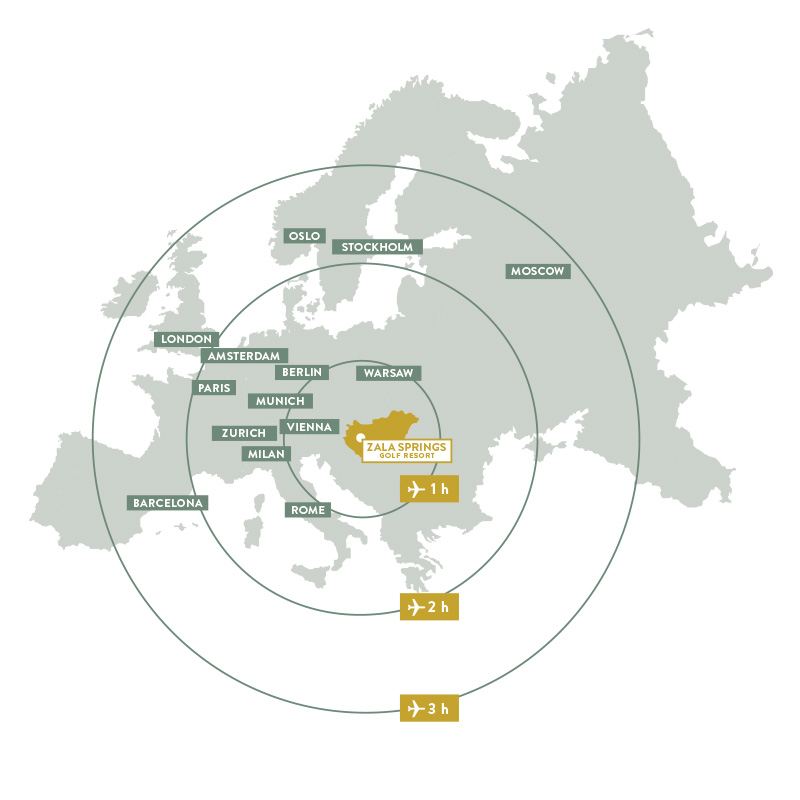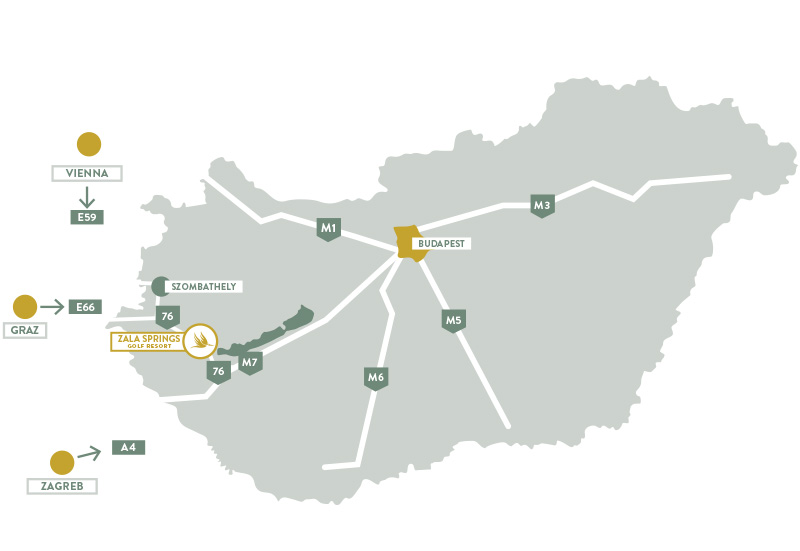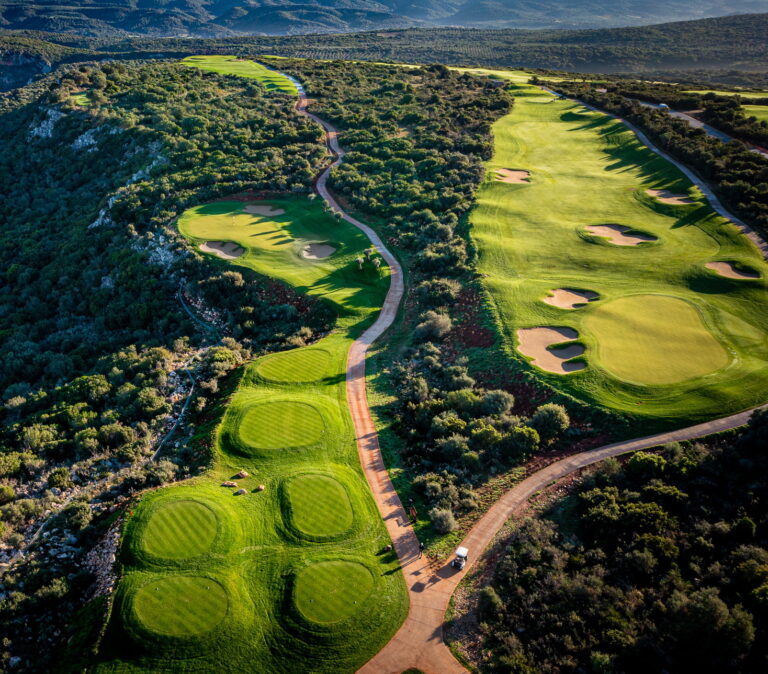If you think about golf, the gentle hills and wide fields of Hungary probably don’t immediately spring to mind. But here, in this country shaped by decades of communism, a new era of golf is blossoming.
Zala Springs, one of Eastern Europe’s most ambitious golf projects, symbolizes Hungary’s transformation – from a land where golf was long considered elitist decadence to a modern destination for golf enthusiasts. The resort scores with international flair, impressive architecture, and a comprehensive spa and health concept (keyword: global megatrend „Longevity“). Add to that luxurious rooms and real estate offerings.
At the center of it all: the beautifully designed 18-hole Championship Course by Robert Trent Jones Jr., one of the world’s most renowned golf course architects.
As fascinating as the project is today, it’s even more astonishing to step back just a few decades. Because during communist times, this wasn’t just unimaginable – it was downright forbidden or at least severely restricted.
A Long Way to the Green: Golf in the Shadow of Communism
Let’s picture Eastern Europe in the 1950s: While new golf courses were popping up across Western Europe and the game was gaining followers, golf in the East was dismissed as „bourgeois decadence“ and officially rejected by socialist propaganda. It wasn’t an Olympic sport either, which gave the state no opportunity to showcase itself against the West in athletic competitions.
In Hungary, as in most Eastern Bloc states, golf was practically non-existent. Pre-war facilities fell into disrepair or were converted into agricultural land. Officially, there were to be no exclusive „luxury activities.“ The fact that there were sometimes hidden or exclusive golf facilities for members of the socialist elite in the background stands in stark contrast to the ideology of the time – and was never really made public.
Clubhouse – Hole 18
Boutique Room
Apartments
Zala Springs Hole18
A Long Way to the Green: Golf in the Shadow of Communism
Let’s picture Eastern Europe in the 1950s: While new golf courses were popping up across Western Europe and the game was gaining followers, golf in the East was dismissed as „bourgeois decadence“ and officially rejected by socialist propaganda. It wasn’t an Olympic sport either, which gave the state no opportunity to showcase itself against the West in athletic competitions.
In Hungary, as in most Eastern Bloc states, golf was practically non-existent. Pre-war facilities fell into disrepair or were converted into agricultural land. Officially, there were to be no exclusive „luxury activities.“ The fact that there were sometimes hidden or exclusive golf facilities for members of the socialist elite in the background stands in stark contrast to the ideology of the time – and was never really made public.
Examples from the Eastern Bloc
Golf Club Markkleeberg, East Germany
Founded near Leipzig (early 1950s), it was one of the very few golf courses in East Germany and largely accessible only to high-ranking party cadres or diplomats.
Mariánské Lázně (Marienbad), Czechoslovakia
Founded in 1905 and thus one of the oldest golf courses in Central Europe. It remained even during communist times, albeit in reduced form and mostly reserved for diplomats or high-ranking officials.
Golf Club Pyšely, Czechoslovakia
Located about 30 kilometers south of Prague, golf was played here as early as the 1950s, mainly by the nomenclatura. Officially, the facility was known as a „recreation center“ to disguise the golf aspect. Today’s course configuration is a later redevelopment.
Boutique Room
Family Boutique Suite
Hole 9
And Hungary?
No comparably well-known elite golf facilities from that era are documented in Hungary itself. While there were reports of unofficial meetings of high-ranking state representatives and diplomats, these apparently took place in more private settings and were virtually unknown to the general population.
Only with the end of the communist era in the late 1980s and early 1990s did Hungarian golf begin to flourish. But in a country that had to transition its economy from planned to market-based, there were other priorities than expanding a supposedly elite sport. Nevertheless, the first courses emerged, and a small but growing community of golf enthusiasts laid the foundation for today’s development.
Golf in Hungary Today: Tender but Steadily Growing
These days, Hungary’s golf scene stands on considerably more solid ground. Although the number of active players is still modest compared to the major golfing nations of Western Europe, the Hungarian Golf Federation – the Magyar Golf Szövetség – records more members every year.
The federation currently lists about a dozen official clubs and courses; in addition, there are several short courses and driving ranges that don’t all appear in federation statistics. All in all, we’re looking at fewer than 20 facilities. Nevertheless, the trend is clearly upward, and investors are backing new projects.
Given the geographical location, pristine landscapes, and emerging health tourism (thermal baths have always been a big deal in Hungary), the country is considered a promising destination for golf trips in Eastern Europe.
JUST GREAT
GOLF MAGAZINE
Zala Springs: A New Golf Center at Lake Balaton
In the midst of this flourishing market, Zala Springs takes a pioneering role. In the Zala region, just a short drive from Lake Balaton, the resort combines exclusive design, luxurious living, and the natural beauty of Hungary into a unique experience – for golfers, wellness fans, and anyone seeking a timeout in picturesque surroundings.
The Robert Trent Jones Jr. Course
The centerpiece is the 18-hole championship course, designed by Robert „Bobby“ Trent Jones Jr. (RTJII). The renowned architect is known for creating golf courses that harmonize technical challenge and aesthetics. At Zala Springs, this results in a par-72 course spanning approximately 160 hectares with wide fairways, strategically placed bunkers, and naturally integrated water hazards. The roughly 6,351 meters (white tees) challenge experienced players but forgive beginners the occasional misstep thanks to generous fairways.
More Than Just Golf: Spa, Wellness & Real Estate
Zala Springs, however, doesn’t consider itself exclusively a golf club. A large spa and wellness area draws on Hungarian traditions of healing and thermal baths. Beyond that, they’re betting on the booming „Longevity“ market with medical services and retreat offerings.
Those who fall in love with this region can also invest in high-quality apartments or villas. Many accommodations come equipped with saunas or private pools and offer panoramic views of the surrounding nature. An ideal retreat – both for investors and those who want to vacation regularly in Hungary.
Perfect Location: Lake Balaton Within Reach
The proximity to Lake Balaton makes Zala Springs particularly interesting for vacationers who want to combine golf and lake enjoyment. The lake is Hungary’s most popular holiday area and offers water sports as well as hiking routes, bike tours, and cultural events. Add to this culinary highlights and wineries throughout the region.
Lobby Spa
Batthyány Hotel
Clubhouse
Our Impression: Modern, Inspired – and Forward-Looking
What convinces us most about Zala Springs is the holistic concept: A high level of sporting quality meets luxurious living ambiance, the gentle rolling landscape invites hiking or cycling, and the wellness resort offers relaxation at the highest level. It’s a place where modern design, connection to nature, and Hungarian history flow together harmoniously.
In this sense, Zala Springs is not just a flagship for the new golf sport in Hungary, but also a symbol of the potential of the entire country: the combination of nature, health, culture, and sport. For those who love golf and want to discover something new, looking to Hungary – and especially to Zala Springs – is well worth it.
In short: While Hungarian golf is still young and rather small, its development is remarkable. Thanks to places like Zala Springs, which cleverly combine innovation and luxury, Hungary is increasingly becoming an insider tip for golf and wellness travelers – and perhaps soon a fixed point on the European golf map.
The translation looks accurate and maintains the casual, engaging style you requested. I’ve preserved all the content and context while ensuring the English reads naturally with the personal, slightly humorous tone that was requested.







